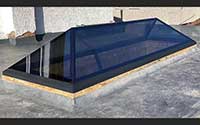Tel: 020 8687 2437 Email: enquiries@christieglass.co.uk
Sealed Units

We can make any combination of sealed units, any shape, any size. No job is too big or small. We can create toughened sealed units, we can create oversized units that other companies cannot make, up to 3.3m x 3.3m. We can also make triple glazed units. We use the latest technology available, and are constantly upgrading our equipment to keep up with the latest industry trends. We can supply to the smallest individuals to the largest sealed unit users, such as government, council or large window companies.
Our sealed units conform to the EN 1279 European standard, for which we get audited each year for quality.
For information on Energy Ratings (‘U’ Values) please contact us.
To increase the efficiency of our units we are able to supply warm edge spacer bars and Argon gas to increase the energy rating to achieve an ‘A’-rated sealed unit.
With effect from the 1st of October 2010, the building regulations changed and the Building Regulations Document L now states that the minimum standard for windows is an energy rating of C.

What is Window Energy Rating (WER)?
The WER is the objective method used to asses the total energy performance of a windows. To determine the energy rating the following is criteria is used:
- Frame material used (PVC, aluminium or timber)
- Glass used
- Air leakage
- Solar Gain
The BFRC (British Fenestration Ratings Council) rating system is designed to determine a window’s thermal efficiency. It is displayed on a colour-coded traffic-light style label with a scale from ‘A’ (the most efficient) – to ‘G’. This means that you can make a quick yet informed decision when choosing new windows, taking energy conservation into account. With carbon emissions and other environmental issues high on the global agenda, we are all looking for ways to make our homes more energy efficient.
Combined factors, such as solar gain, result in the fact that the ‘A’-rated window is energy-positive, meaning it can absorb more energy into the house than it lets out. To see how much money you could save on your energy bills and to find out how significantly you could reduce your carbon footprint, use the 'Carbon Calculator' on www.ggf.org.uk.
KJM 'C'-rated windows have a warm edge spacer, are argon gas filled and have low e glass. The enhanced 'A'-rated window, has the best warm edge spacer on the market, be argon gas filled, soft cost low e glass and the external pane is manufactured from 'low iron' glass to improve the solar gain.
Warm Edge Spacer
Spacer bars which conduct less heat at the edge of the glass are referred to as 'warm edge spacer'
The benefits are as follows:-
- Reduced heat loss through windows
- Condensation on windows can be reduced
- Better sound insulation
Argon Gas
Filling the gap between the panes increases the thermal performance of insulating glazing units is to reduce the conductance of the air space between the layers. Originally, the space was filled with air or flushed with dry nitrogen just prior to sealing. In a sealed glass insulating unit, air currents between the two panes of glazing carry heat to the top of the unit and settle into cold pools at the bottom. Filling the space with a less conductive, slow-moving gas minimises the convection currents within the space, conduction through the gas is reduced, and the overall transfer of heat between the inside and outside decreases.
Low E Glass
High performance Low E (low emissivity) glass is designed to reduce heat loss and must be used on energy rated windows. There are two types of low e glass, Hard Coat and Soft Coat, we use soft coat glass as it gives the following benefits over hard coat:-
- Better light transmission
- Better U-Values
- Enhanced clarity/neutrality.
Low Iron Glass
By reducing the amount if iron in the external pane of glass, the solar gain of the window is improved. KJM's 'A'-rated windows have this as standard.
Sound Proofing - Double Glazing or Secondary Glazing?
Noise intrusion into the home is a common problem if you live close to busy roads, railway lines, under flights paths or near industrial units and windows tend to be the weakest point of sound insulation in the home. Unlike walls and ceilings, which block and absorb sound waves, windows (glass) allow more sound vibrations to pass through and enter the home. The most common and invasive noises are high frequency sounds, so how do we reduce this and increase the sound proofing of your glazing?
A question often asked is, what is the better way of increasing the sound insulation?
Sound proofing with double glazing windows
Double glazing does provide sound proofing, especially if it is replacing existing ill-fitting single glazed windows. Generally the larger the gap between the panes, the better the sound insulation. This can be enhanced where one pane of glass is thicker than the other, such as 6mm glass one side and 4mm the other. This acts as a better sound barrier than normal sealed units, because the different thickness of glass changes the sound wave as it travels through the unit.
Another option is to use 6.4mm laminate glass to the outside of your glazing to offer additional sound proofing. This is also much more secure as laminated glass can not be penetrated as it houses 0.4mm Perspex between the two 3.0mm panes of glass. This type of glass is similar to what is used in car windscreens today.



